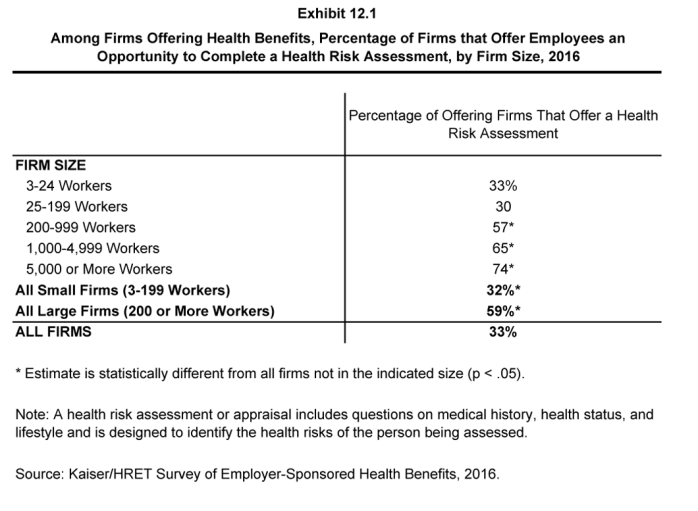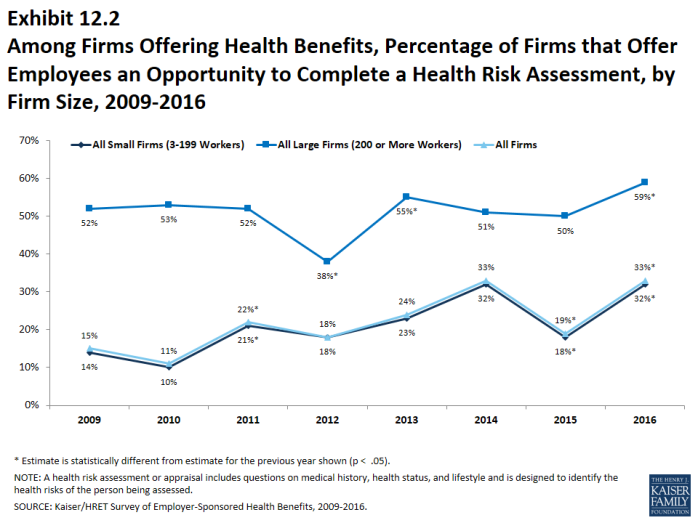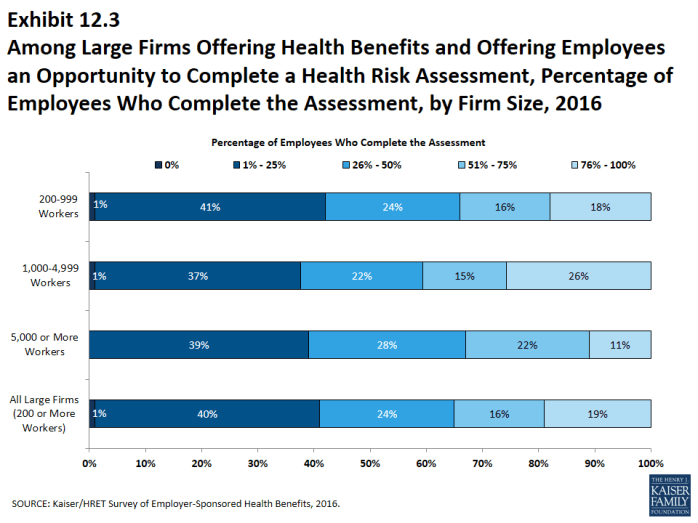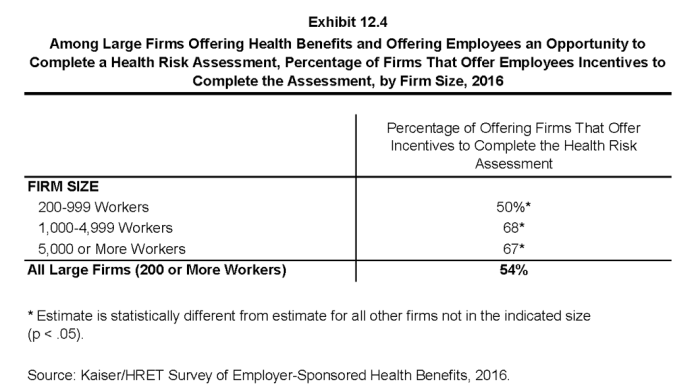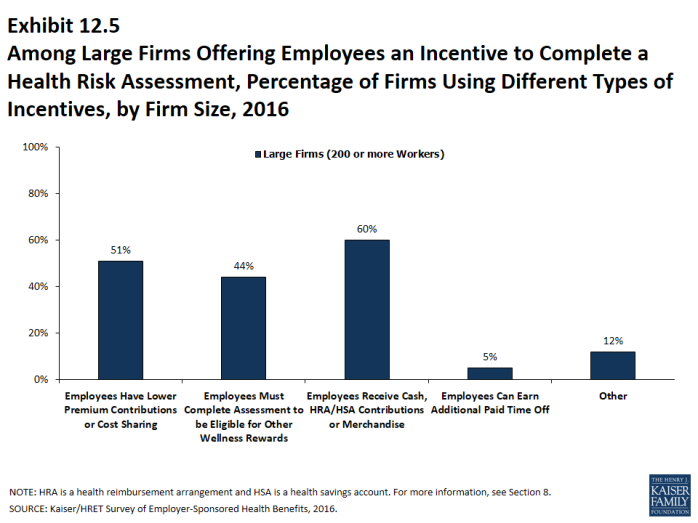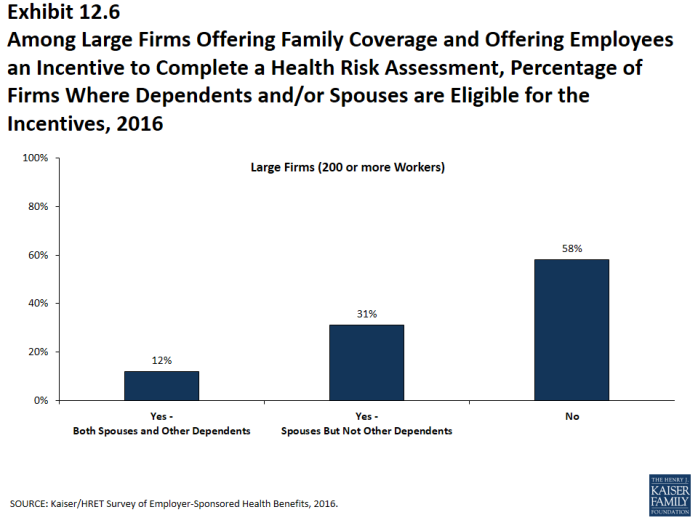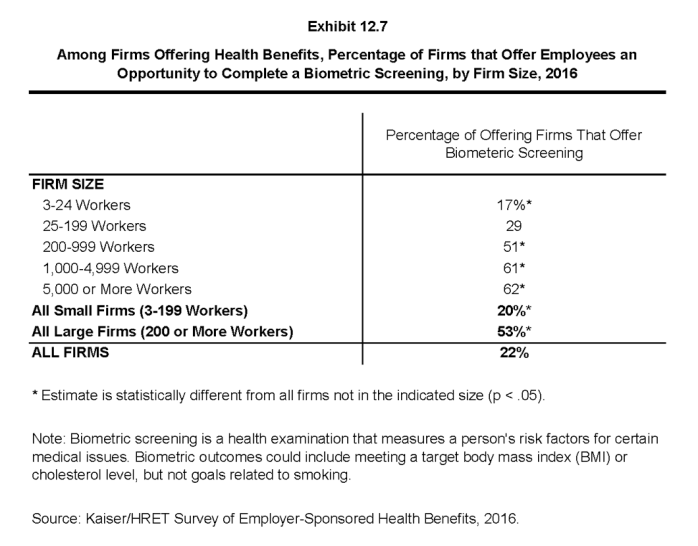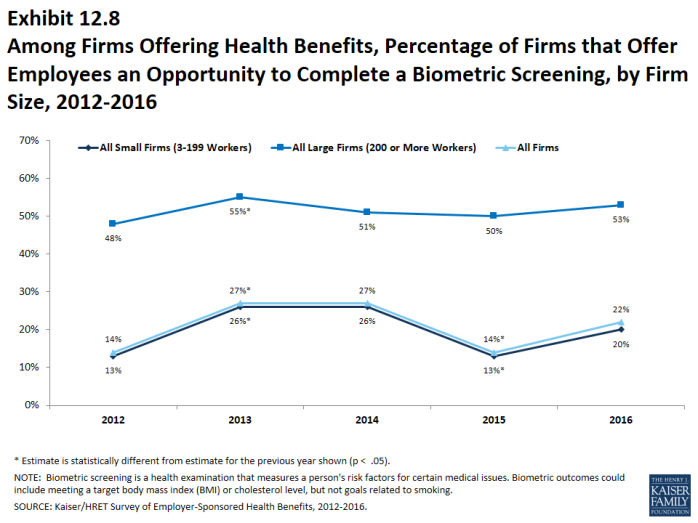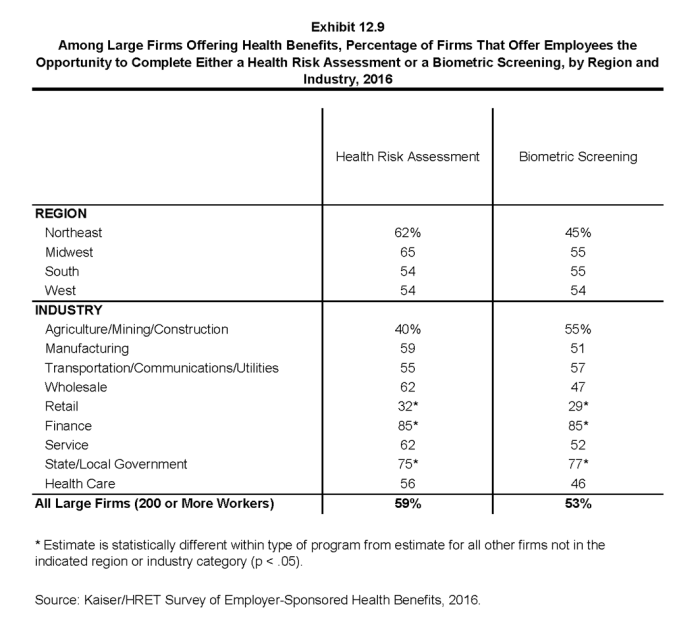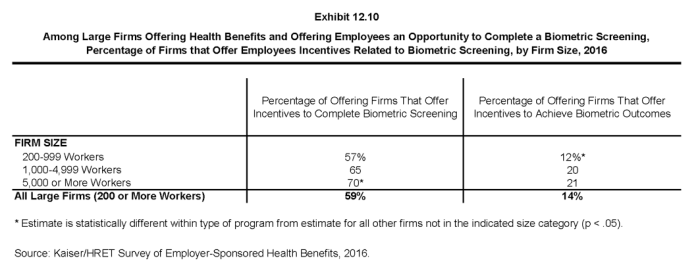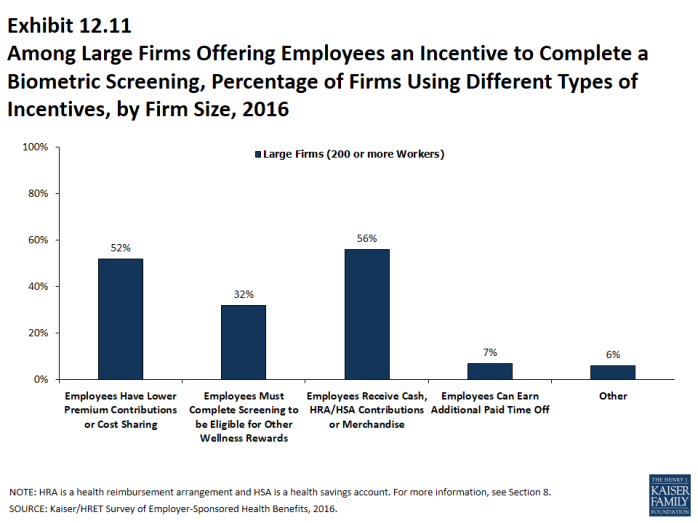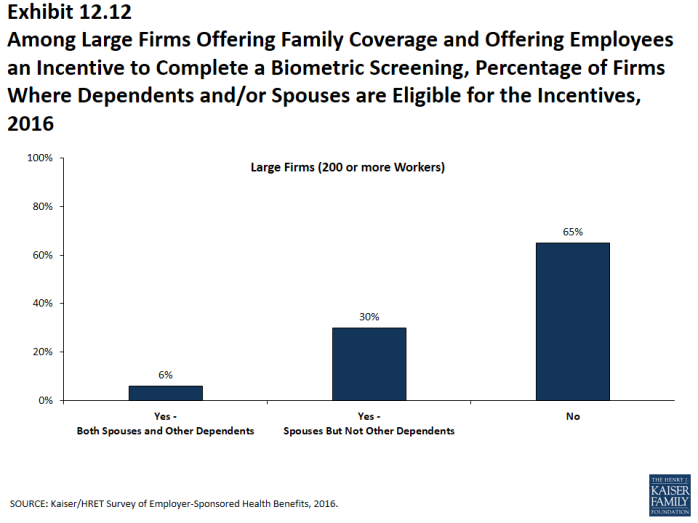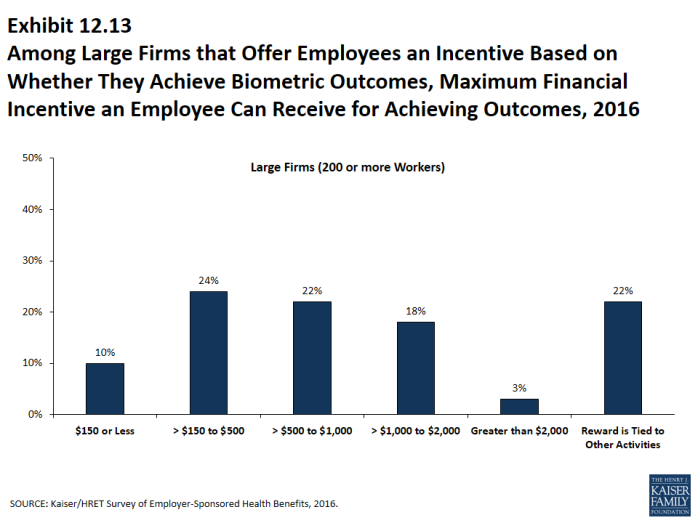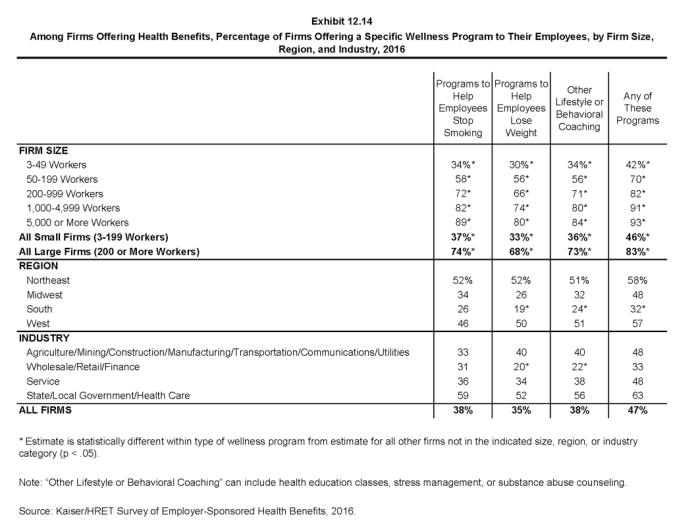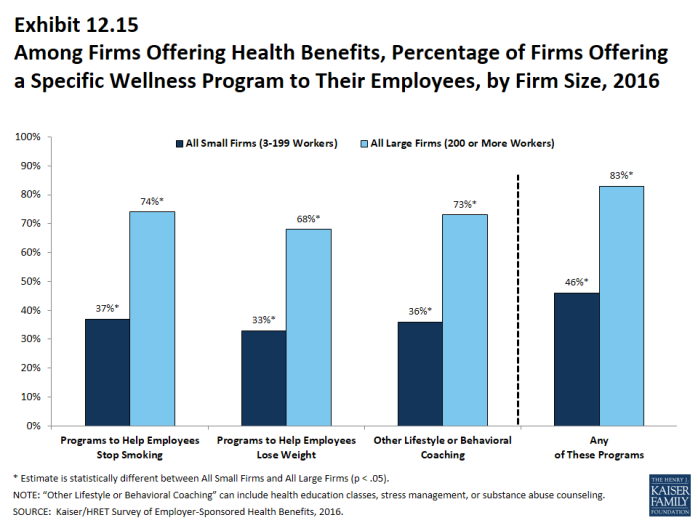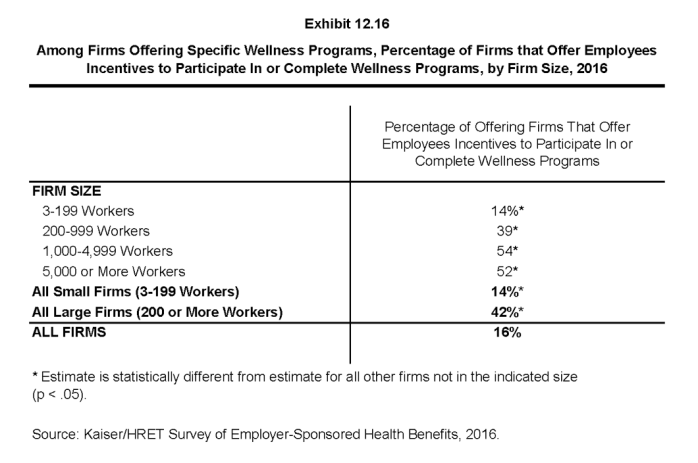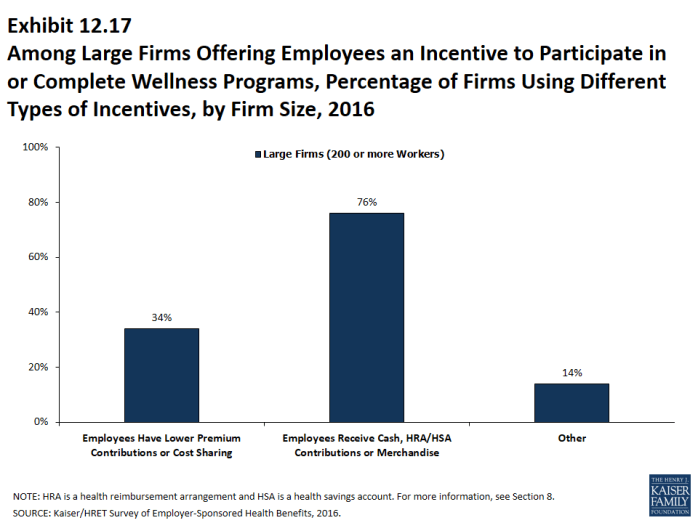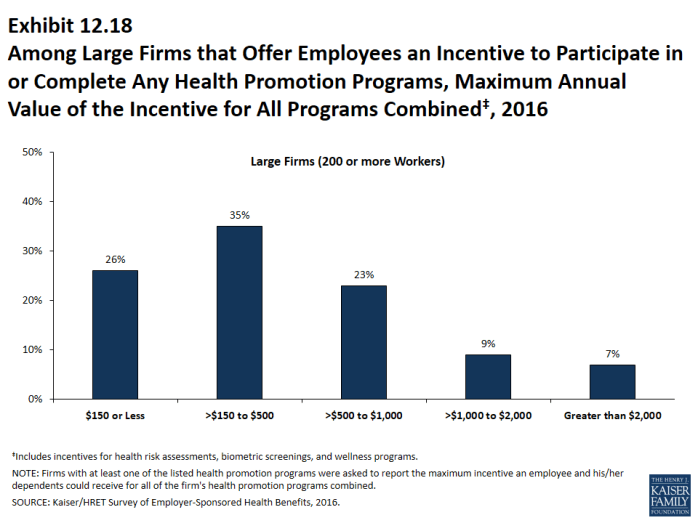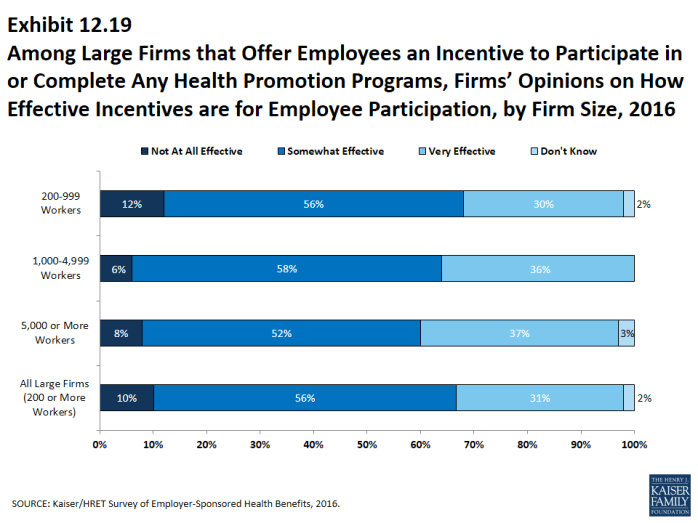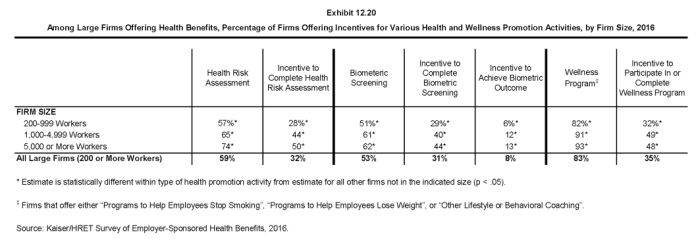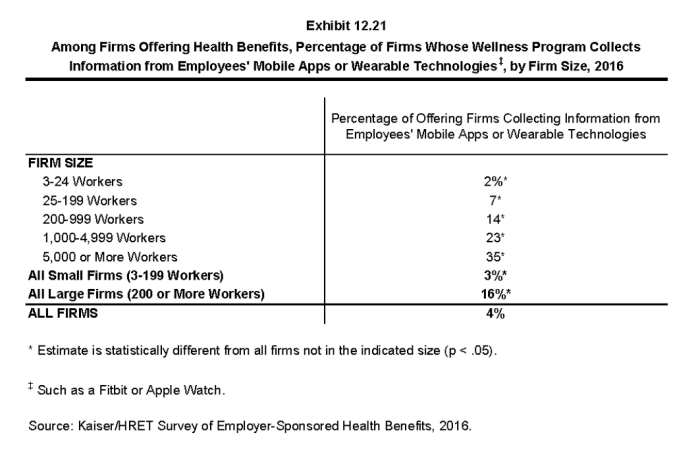2016 Employer Health Benefits Survey
Section Twelve: Health Risk Assessment, Biometrics Screening and Wellness Programs
Employers continue to show considerable interest in programs that help employees identify health issues and manage chronic conditions. Many employers believe that improving the health of their workers and their family members can improve morale, productivity and reduce health care costs.
In addition to offering wellness programs, a majority of large employers now offer health screening programs including health risk assessments, which are questionnaires asking employees about lifestyle, stress or physical health, and biometric screening, which we define as in-person health examinations conducted by a medical professional. Employers and insurers may use the health information collected during screenings to target wellness offerings or other health services to employees with risk conditions or behaviors that pose a risk for their health. Some employers have incentive programs that reward or penalize employees for different activities, including participating in wellness programs or completing health screenings.
In 2015 we revised the survey to better capture employers’ evolving approaches to wellness programs and health screening, including collecting information on employers’ use of incentive programs, so in most cases, statistics reported in 2015 and 2016 are not comparable to previous years’ findings because of these changes. Only firms offering health benefits were asked about their wellness and health promotion programs. Information about incentives is reported only for large firms (200 or more employees) because large shares of small firms (3-199 workers) did not know this information about their programs.
In 2016, of large firms offering health benefits, 59% offer employees the opportunity to complete health risk assessments, 53% offer employees the opportunity to complete biometric screening, and 83% offer employees wellness programs such as programs to help employees stop smoking, programs to help employees lose weight, or other lifestyle and behavioral coaching. Substantial shares of these large firms provide financial incentives for employees to participate in or complete the programs.
Health Risk Assessments
Some firms provide their employees the opportunity to complete a health risk assessment to identify potential health issues. Health risk assessments generally include questions about medical history, health status, and lifestyle.
- Among firms offering health benefits, 32% of small firms and 59% of large firms provide employees the opportunity to complete a health risk assessment (Exhibit 12.1). Each of these is higher than the corresponding percentage for 2015 (18% for small firms and 50% for large firms) (Exhibit 12.2).
- Seventy-four percent of firms offering health benefits with 5,000 or more employees provide employees the opportunity to complete a health risk assessment, similar to the percentage last year (72%) (Exhibit 12.1).
- Some firms offer financial incentives to encourage employees to complete health risk assessments.
- Among large firms that have a health risk assessment, 54% offer an incentive to employees to complete the assessment (Exhibit 12.4). Some firms offer more than one type of incentive to employees.
- Among large firms offering incentives for employees to complete a health risk assessment, 51% lower premium contributions or reduce cost sharing; 60% offer cash, gift cards, merchandise or contributions to HSAs or HRAs; 44% require completion of a health risk assessment to be eligible for incentives under wellness or health promotion programs; and 5% offer additional paid time off (Exhibit 12.5).
- Forty-one percent of covered workers in large firms providing the opportunity to complete a health risk assessment complete the assessment, similar to the percentage in 2015 (45%).
- There is considerable variation in the percentage of workers who complete the assessment. Nineteen percent of large firms providing employees the opportunity to complete a health risk assessment report that more than 75% of their employees complete the assessment, while 41% report no more than 25% of employees complete the assessment (Exhibit 12.3).
Biometric Screening
Biometric screening is a health examination that measures an employee’s risk factors for certain medical issues such as cholesterol, blood pressure, stress, and nutrition. Biometric outcomes may include meeting a target body mass index (BMI) or cholesterol level. As defined by this survey, goals related to smoking are not included.
- Among firms offering health benefits, 20% of small firms and 53% of large firms provide employees the opportunity to complete biometric screenings (Exhibit 12.7). These percentages are similar to last year (13% and 50%) (Exhibit 12.8).
- Sixty-two percent of firms offering health benefits with 5,000 or more workers have biometric screening programs (Exhibit 12.7).
- Firms that provide employees the opportunity to complete biometric screenings may include additional incentives for those employees who do so.
- Among large firms with biometric screening programs, 59% offer an incentive for employees to complete the screening (Exhibit 12.10). Firms with 5,000 or more employees with biometric screening programs are more likely to have an incentive to complete the screening (70%) than firms in other size categories. Some firms report having more than one type of incentive.
- Among large firms with an incentive for employees to complete biometric screening, 52% lower premium contributions or reduce cost sharing; 56% offer cash, gift cards, merchandise or contributions to HSAs or HRAs; 32% require completion of the screening to be eligible for incentives under wellness or health promotion programs; and 7% offer additional paid time off (Exhibit 12.11).
- Among large firms with biometric screening programs, 14% have rewards or penalties for workers based on achieving specified biometric outcomes (e.g., meeting target BMI) (Exhibit 12.10).
- There is considerable variation in the size of the incentives that employers offer for meeting biometric outcomes. Among large firms offering a reward or penalty for meeting biometric outcomes, the maximum reward is valued at a $150 dollars or less for 10% percent of firms and $1,000 or more for 21% of firms (Exhibit 12.13). Twenty-two percent of these firms combine the reward with incentives for other programs.
Wellness and Health Promotion Programs
Many employers and health plans offer programs to help employees engage in healthy lifestyles and reduce health risks. Wellness and health promotion programs may include exercise programs, health education classes, and stress-management counseling. These programs may be offered directly by the firm, an insurer, or a third-party contractor.
- Among firms offering health benefits, 37% of small firms and 74% of large firms offer programs to help employees stop smoking, 33% of small firms and 68% of large firms offer programs to help employees lose weight, and 36% of small firms and 73% of large firms offer some other lifestyle or behavioral coaching program. Forty-six percent of small firms and 83% of large firms offering health benefits offer at least one of these three programs (Exhibit 12.15).
- To encourage participation in wellness programs, firms may offer financial incentives to employees who participate in or complete wellness programs.
- Forty-two percent of large firms offering one of these wellness or health promotion programs offer an incentive to encourage employees to participate in or complete the programs (Exhibit 12.16). Fifty-two percent of firms with more than 5,000 employees offering one of these wellness or health promotion programs offer an incentive to participate in or complete the programs.
- Among large firms offering incentives to employees to participate in or complete wellness or health promotion programs, 34% lower premium contributions or reduce cost sharing; 76% offer cash, gift cards, merchandise or contributions to HSAs or HRAs; and 14% have some other type of incentive (Exhibit 12.17).
- Firms with incentives for health risk assessment, biometric screening, or wellness or health promotion programs were asked to report the maximum reward or penalty an employee could earn for all of the firm’s health promotion activities combined. Some employers do not offer incentives for individual activities, but offer rewards to employees who complete a variety of activities. Among large firms offering incentives for any of these programs, the maximum value for all wellness-related incentives is $150 or less in 26% of firms and more than $1,000 in 16% of firms (Exhibit 12.18).
- Firms with incentives for health risk assessment, biometric screening, or wellness or health promotion programs were also asked how effective they believed incentives were for encouraging participation. Thirty-one percent of large firms offering incentives for any one of these programs say the incentives are “very effective” at encouraging employees to participate, 56% say that the incentives are somewhat effect, while 10% say the incentives are not effective (Exhibit 12.19).
- Among firms offering health benefits, 3% of small firms and 16% of large firms collect information from employees’ wearable devices, such as a Fitbit or Apple Watch, as part of their wellness or health promotion program (Exhibit 12.21).

